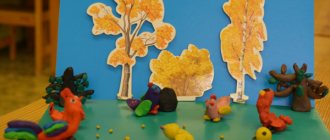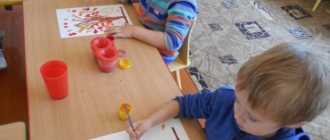GCD on “Artistic and Aesthetic Development” Topic: “Matryoshka Doll Painting”
GCD on “Artistic and Aesthetic Development”
Topic: “Matryoshka doll painting”
Target:
introducing children to the decorative painting of the folk toy - nesting dolls
Software tasks:
1.Educational
• consolidate children's knowledge about the history of the creation of the Russian wooden nesting doll, about its characteristic features;
• continue to get acquainted with the creativity of Russian folk art: painting of nesting dolls;
• consolidate practical skills in drawing elements of Semenovskaya painting;
2.Developing
• develop thinking, fine motor skills, artistic taste;
• develop children's creative abilities through exposure to folk art and applied arts;
• develop independence in coming up with a design for a sundress for a nesting doll.
3. Educational
• develop the ability to work in a team;
• cultivate independence, accuracy, interest and love for folk toys;
• cultivate respect for the creativity of Russian craftsmen.
Integrated educational areas:
“Cognition”, “Communication”, “Socialization”, “Music”, “Physical education”, “Health”.
Preliminary work: the teacher’s story about the history of the emergence of nesting dolls, their production and painting; examination of toys - nesting dolls and illustrations depicting nesting dolls of Semyonovsky, Zagorsky, Polkhov-Maidansky, comparing them in appearance, appearance, painting; reading poetry, riddles about nesting dolls.
Methodical techniques:
— Verbal
— Gaming
— Visual
Demo material:
presentation “Russian nesting doll”, easel, silhouettes of nesting dolls, illustrations with elements of different painting techniques, audio recordings “Russian folk melodies”
Handouts: nesting doll templates, paints, brushes, cotton swabs, woolen thread, jars of water, napkins.
Progress of the lesson:
1. Organizational moment.
(A folk melody sounds at the beginning of the lesson.)
There's a knock on the door. The teacher brings in a doll in Russian folk costume. She has an envelope in the rivers.
Educator: Guys, look what a beautiful doll, and she has an envelope in her hands, she probably brought us a letter. Let's read it.
The children sit on chairs, the teacher reads the letter: “Hello, dear children. Masters of Russian folk toys are writing to you. We have a lot of orders and we can't cope. We would like to ask you to help us make Russian folk toys."
2. Problem situation.
Educator: Guys, what Russian folk toys can you and I make?
Children's answers.
3. Statement of the topic and purpose of the lesson.
Educator: I have blank dolls, but they are not painted. I suggest you write them down. But first, let's remember what kind of nesting dolls there are and how they are painted.
4. Repetition of learned material
(slide 2)
There are dolls that have one name - Matryoshkas
(slide 3)
Why is this doll so loved? Because she's special. Disassembles into two parts. Take off the top one and see that there is still a doll inside. The same nesting doll, only smaller, and also opens up.
(slide 4)
The first nesting doll appeared almost a hundred years ago. Toy maker V. Zvezdochkin from the city of Sergiev Posad made a disassembled doll from wood, and artist S. Malyutin painted it. It turned out to be a girl, pink-cheeked, with flaxen hair, in simple peasant clothes - a sundress, an apron, and a scarf with flowers. With his right hand he presses a black rooster to himself.
(slide 5)
Why is the nesting doll called that?
In the old Russian village, the common and favorite female names were Matryona, Matryosha. This name means “mother”. That's why they called the doll Matryoshka.
(slide 6)
Matryoshka dolls are made mainly from linden, birch, alder, and aspen. Masters make matryoshka dolls starting with the smallest ones.
(slide7)
The craftswomen paint the finished figurines with bright colors - they “dress” the doll in colorful sundresses and colored scarves. And then the most difficult thing is to draw the face: eyes, crimson lips, blush - and the nesting doll “came to life.” They are also varnished for liveliness and shine.
(slide 
Matryoshka dolls were painted differently in different villages.
Sergievo Pasadsky - stable, thick-sided. In multi-colored aprons, in red, blue, green scarves.
(slide 9)
Matryoshka from Semenov - in colorful aprons, yellow and red shawls.
(slide 10)
And in the village of Polkhovsky Maidan, near the nesting dolls, raspberry berries, flowers, and green leaves are “scattered” on a yellow background. And they are slimmer.
(slide 11)
Sometimes the nesting dolls are unusual - they are a large peasant family.
(slide 12)
These are the heroes of fairy tales familiar to everyone.
(slide 13)
But still the most favorite was the nesting doll. Today it is known all over the world and is given as a souvenir of our country. It became a Russian souvenir.
5. Physical exercise.
(Musical round dance)
6. Practical part
Educator: I suggest you paint our nesting dolls in Semyonov style. Let's start painting with the scarf. What color?
Children's answers.
Educator: We place small flower buds along the edge of the scarf. We will draw them by dipping a cotton swab. The matryoshka’s apron is painted with roses; you and I can paint roses with woolen thread. Remember how we draw them?
Children's answers.
Educator: Now we take a brush and paint the bottom of the nesting doll. While we were painting the bottom, the roses dried up and complemented them with green leaves and scarlet flowers. The face is round, bright blush, black eyebrows, small mouth. The same image of a Russian beauty was sung in Russian songs and fairy tales.
7. Summing up.
(Organization of an exhibition of children's works)
— Well done, children, everyone did a wonderful job. When the paint dries, we will send the nesting dolls to the craftsmen.
On the topic: methodological developments, presentations and notes
Summary of a lesson on familiarizing children with their surroundings. Topic: “Toys. Getting to know the Russian nesting doll" - from a series of integrated lessons on the topic: "Matryoshka".
The activity will help introduce children to the folk toy - matryoshka. Integration of educational areas: "Cognition", "Artistic creativity", "Communication", "Music".
Long term project. For preschool teachers.
Application for the middle group of kindergarten, from the “Our Motherland” section.
Program content: Educational objectives: Tell about the most popular folk wooden toy, nesting dolls. Teach children to distinguish between different techniques for painting nesting dolls. Develop children's creative imagination.
Introduction to Russian folk culture should be introduced from early childhood.
Source
GCD for drawing in the preparatory group “Merry dolls”
Marina Shekel
GCD for drawing in the preparatory group “Merry dolls”
Program content: continue to introduce children to the nesting doll as a type of folk toy (history of creation, features of appearance and decor, source material, the most famous crafts - Semyonovskaya, Polkhov-Maidanskaya, develop the ability to draw a nesting doll from life , as accurately as possible conveying the shape, proportions and design elements, develop an eye, a sense of color, shape, rhythm, proportion, cultivate interest in folk culture, aesthetic taste.
The main stages of depicting a matryoshka doll
According to Russian tradition, wooden toys that are nested inside one another have always been painted. The souvenir has many styles. The name of the painting is associated with the area where it was made. For example, Zagorskaya, Kirovskaya, Semenovskaya, Turinskaya and so on.
Using these instructions, you can learn how to draw a wooden toy either on paper or another base (egg, stone, etc.):
| Part of work | Execution Description |
| Head | Draw a small circle. To obtain smooth edges of a geometric figure, you can use a compass or a round object of various diameters - saucers, lids, cups and others. |
| Torso | Below, draw a second circle, but larger. Both circles should touch each other. |
| Form | To get the traditional shape of a wooden toy, the circles need to be connected with smooth lines, and the excess parts should be removed with an eraser. |
| Face | Draw a face inside the first circle, which is also shaped like a circle. On the face draw eyes, nose, mouth, eyebrows, and round cheeks. In the upper part of the face, draw hair covering the forehead. |
| Handkerchief | At the bottom of the face circle, draw a knot in the scarf. Separate the scarf from the body with wavy lines. |
| Toy decoration | At the bottom of the figure, draw a base on which the toy stands. In the center of the body, divide the upper part of the figure from the lower half with a semicircular line. Erase unnecessary lines and make the contours brighter. |
| Apron | Decorate the lower part of the toy with colorful patterns consisting of flowers and decorative lines. |
| Coloring | Give your face a light beige tint, make your cheeks red, and your hair light brown. The base of the toy should be brown, and the patterns should be bright. |
Before the children start drawing, you can show them a visual material with a picture of a nesting doll, and also lay out the manual on the tables.
Then perform the following steps step by step with a pencil:
- The first step is to draw a circle, which will be the top part of the nesting doll.
- Draw a lower oval and connect it to the head.
- In the central part of the upper circle draw a round face and hair.
- Draw eyes, lips and eyebrows on the face.
- Under the circle that represents the face, add a bow and an apron.
The matryoshka doll (the drawing for children must match the description) can be brought to life. To do this, you need to color her sundress and scarf. Young artists can find their favorite rich colors. The sundress can be decorated with floral patterns or bright berries. Or you can invite children to color a ready-made black and white image of a nesting doll.
Simple drawing with felt-tip pens
A matryoshka doll (a drawing for children does not have to be completely filled in with a felt-tip pen) can be drawn with dashes of different lengths, dots, and squiggles.
The result will be a more accurate picture.
- Use a black felt-tip pen to draw a circle as evenly as possible.
- Below, on the outside of the circle, draw a knot and a bow.
- Draw hair inside the circle: 2 arcs, starting from one top point and ending on different sides of the circle.
- Draw 2 eyes in the central part of the head, and a smile just below.
Draw a big eight like this:
- Draw a semicircle above your head, 1 cm from it.
- Draw a second arc at the bottom of the sheet. Its size must be larger than the first arc.
- Connect the left edge of the upper arc with the left edge of the lower arc with a line curved inward.
- Connect the right edge of the upper arc with the right edge of the lower arc with a line curved inward.
This will create a toy figure.
Further:
- Draw smooth lines that form the edge of the scarf.
- Draw an apron, the upper part of which rests on the scarf.
- Draw hands on the sides of the matryoshka (between the apron and the edge of the toy). The sleeve line begins where the scarf ends and is formed from a small rectangle.
- Draw a flower in the center of the apron.
To color the sketch, you need to take felt-tip pens in the following shades: yellow, orange, beige, light and dark brown, green and red:
- Use a yellow marker to color the apron.
- Use an orange felt-tip pen to color the lower part of the nesting doll (dress).
- In order to paint your face, you need to choose a shade of flesh color.
- Use a light brown felt-tip pen to color your hair. Then take a dark brown felt-tip pen and draw several stripes through your hair to create shimmer.
- Color the scarf green.
- Color the flower on the apron red.
- Put red dots on the dress.
- Draw a spiral pattern on the apron in orange, bordering the apron in a circle.
- Color your hands with a flesh-colored felt-tip pen.
Simple drawing
To draw a simple drawing with your child, you need to follow several steps:
- Draw an egg with a blunt base.
- Draw a narrow stand on the base.
- At the top of the resulting oval, draw a circle for the face and bangs.
- Draw a face: eyes, nose, cheeks, smile and hair.
- Draw arms on both sides of the body.
To put on a matryoshka doll, you need:
- Draw 2 smooth lines under the circle of the face from the center to the sides. You will get a scarf.
- Draw the knot and ends of the scarf.
- At the bottom of the figure, draw the hem of the sundress.
- Draw any pattern on the apron: flower, berries, circles, and so on.






